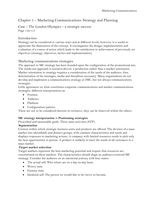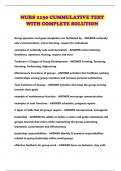Week 1
Pettersson et al: Organized violence 1989-2020, with a special
emphasis on Syria
- Uppsala Conflict Data Program: falling trend in fatalities of organized violence broke upwards in
2020, deaths from organized violence settled on a high plateau
- decrease in violence in Syria and Afghanistan countered by Nagorno-Karabakh, Azerbaijan,
Ethiopia
- number of active state-based and non-state conflicts, one-sided violence increased compared to 2019
⇒ 56 state-based conflicts in 2020, including 8 wars and 30 conflicts in Africa
- covid-19 did not lead to reduced violence
- shift from Middle East to Africa in organized violence
,State-based conflict, 1946–2020
- 2020 saw examples of escalating violence in conflicts that had been inactive (China-India border –
Galwan Valley, Azerbaijan)
- Tanzania: Islamic State was a completely new conflict
- 2019: much increase in conflict due to Islamic State moving to new areas
- trend of decreasing number of battle-deaths continued in 2020 but this number is largely driven by
Syria and Afghanistan and the reduction in violence here was not due to pandemic
- decrease in violence in Afghanistan due to peace process and drastic drop in airstrikes by US but still
this conflict accounted for 40% of conflict-deaths in 2020
- covid-19 was even driving force behind some conflicts flaring up in 2020 (DR Congo)
- 8 conflicts reached the level of war in 2020 → increase by 1 since 2019 (80% of deaths)
Non-state conflict, 1989–2020
- non-state conflict increased in 2020, in terms of both the number of active conflicts and the number
of deaths incurred in fighting between non-state groups
- 72 non-state conflicts in 2020
- Middle East replaced by Americas, esp. Mexico, then Brazil
- Mexican and US counter-drug efforts increased cartel fragmentation and in-fighting → increased
fragmentation associated with increased violence
,One-sided violence, 1989–2020
- 39 actors carrying out one-sided violence in 2020
- mainly in Africa (7,000 out of 7,700 intentional killings here) explainable by shift of IS from ME to
Africa (Mozambique, DR Congo)
Conflicts in Syria, 2011–2020
- Syria has dominated the trend of fatalities in the world since the start of the uprising in 2011,
remained the country with the most fatalities in state-based violence until 2018
- since 2016, the state-based conflicts in Syria have seen a massive decline in fatalities, from over
41,000 fatalities that year to just over 4,500 in 2020
- war in Syria not yet over as much of the country is controlled by non-state actors backed by Turkey
or US
- collapse of state authority in many areas in Syria contributed to the intensity of conflict
- this conflicts resembles conventional war rather than counterinsurgency
- peak of one-sided violence in Syria was 2011–2013 when the gov suppressed Arab Spring
- then the one-sidedness came from IS
- collapse of IS in Syria has largely driven the decline in non-state violence in Syria but globally this
was counteracted by a surge in non-state violence in Mexico
, Green: How to read Political Science: A guide in four steps
- empirical poli sci, single articles, chapters not whole books
- what to do when reading an article
1) title, headings, abstract
a) what is the article about?
2) skim for signposts
a)
3) read strategically
a) read twice: briefly and less briefly
b) then actually read
c) read more attentively where there are many signposts
d) describe each paragraph with 1-3 words
e) take notes on key assumptions, conclusions
4) review
a) new terms, concepts, main questions, arguments, evidence, assumptions
b) be critical about it
Stubbs: War and Economic Development
● war and the development of economies, states, and societies have historically been
intertwined
● however, the economic consequences of wars and preparation for war have received little
attention beyond Europe and major powers
● from the 1940s to the 1980s, East and Southeast Asia were beset by various wars, but they
also saw the emergence of strong states and expanding economies
● the location of East and Southeast Asia as a battleground in the second world war and
subsequent American attempts to contain Asian Communism has provided a significant
geostrategic context for rapid economic development
● the economies of the seven successful countries in East and Southeast Asia have moved in the
same general direction, achieving rapid economic growth primarily through changing from
import-substitution industrialization to export-oriented industrialization (Japan, South
Korea, Taiwan, Hong Kong, Singapore, Malaysia, and Thailand)
Effects of War
Pettersson et al: Organized violence 1989-2020, with a special
emphasis on Syria
- Uppsala Conflict Data Program: falling trend in fatalities of organized violence broke upwards in
2020, deaths from organized violence settled on a high plateau
- decrease in violence in Syria and Afghanistan countered by Nagorno-Karabakh, Azerbaijan,
Ethiopia
- number of active state-based and non-state conflicts, one-sided violence increased compared to 2019
⇒ 56 state-based conflicts in 2020, including 8 wars and 30 conflicts in Africa
- covid-19 did not lead to reduced violence
- shift from Middle East to Africa in organized violence
,State-based conflict, 1946–2020
- 2020 saw examples of escalating violence in conflicts that had been inactive (China-India border –
Galwan Valley, Azerbaijan)
- Tanzania: Islamic State was a completely new conflict
- 2019: much increase in conflict due to Islamic State moving to new areas
- trend of decreasing number of battle-deaths continued in 2020 but this number is largely driven by
Syria and Afghanistan and the reduction in violence here was not due to pandemic
- decrease in violence in Afghanistan due to peace process and drastic drop in airstrikes by US but still
this conflict accounted for 40% of conflict-deaths in 2020
- covid-19 was even driving force behind some conflicts flaring up in 2020 (DR Congo)
- 8 conflicts reached the level of war in 2020 → increase by 1 since 2019 (80% of deaths)
Non-state conflict, 1989–2020
- non-state conflict increased in 2020, in terms of both the number of active conflicts and the number
of deaths incurred in fighting between non-state groups
- 72 non-state conflicts in 2020
- Middle East replaced by Americas, esp. Mexico, then Brazil
- Mexican and US counter-drug efforts increased cartel fragmentation and in-fighting → increased
fragmentation associated with increased violence
,One-sided violence, 1989–2020
- 39 actors carrying out one-sided violence in 2020
- mainly in Africa (7,000 out of 7,700 intentional killings here) explainable by shift of IS from ME to
Africa (Mozambique, DR Congo)
Conflicts in Syria, 2011–2020
- Syria has dominated the trend of fatalities in the world since the start of the uprising in 2011,
remained the country with the most fatalities in state-based violence until 2018
- since 2016, the state-based conflicts in Syria have seen a massive decline in fatalities, from over
41,000 fatalities that year to just over 4,500 in 2020
- war in Syria not yet over as much of the country is controlled by non-state actors backed by Turkey
or US
- collapse of state authority in many areas in Syria contributed to the intensity of conflict
- this conflicts resembles conventional war rather than counterinsurgency
- peak of one-sided violence in Syria was 2011–2013 when the gov suppressed Arab Spring
- then the one-sidedness came from IS
- collapse of IS in Syria has largely driven the decline in non-state violence in Syria but globally this
was counteracted by a surge in non-state violence in Mexico
, Green: How to read Political Science: A guide in four steps
- empirical poli sci, single articles, chapters not whole books
- what to do when reading an article
1) title, headings, abstract
a) what is the article about?
2) skim for signposts
a)
3) read strategically
a) read twice: briefly and less briefly
b) then actually read
c) read more attentively where there are many signposts
d) describe each paragraph with 1-3 words
e) take notes on key assumptions, conclusions
4) review
a) new terms, concepts, main questions, arguments, evidence, assumptions
b) be critical about it
Stubbs: War and Economic Development
● war and the development of economies, states, and societies have historically been
intertwined
● however, the economic consequences of wars and preparation for war have received little
attention beyond Europe and major powers
● from the 1940s to the 1980s, East and Southeast Asia were beset by various wars, but they
also saw the emergence of strong states and expanding economies
● the location of East and Southeast Asia as a battleground in the second world war and
subsequent American attempts to contain Asian Communism has provided a significant
geostrategic context for rapid economic development
● the economies of the seven successful countries in East and Southeast Asia have moved in the
same general direction, achieving rapid economic growth primarily through changing from
import-substitution industrialization to export-oriented industrialization (Japan, South
Korea, Taiwan, Hong Kong, Singapore, Malaysia, and Thailand)
Effects of War










